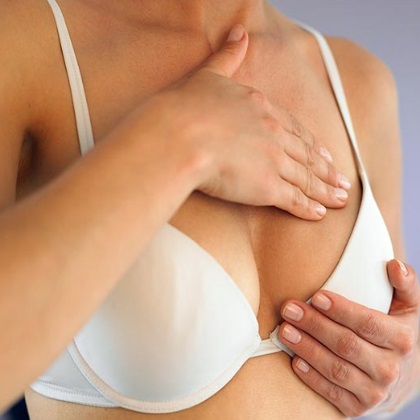 New Health Guide
New Health Guide
Breast pain can be very distressing and frightening for women. It can appear as a sharp pain or feeling of discomfort and tighteningin the breasts. This pain may occur periodically, but may also be constant. In both cases,pain in breast causes concerns and doubtsto whether this is a serious illness. Although this is a common problem among women, the causes may be different-some are negligible while others are really serious.
Cyclic breast pains occur periodically, most often in premenopausal women. Their intensity varies during the menstrual cycle and depends on the change in hormones, and they are most intense a few days before menstruation. This pain is characterized by a feeling of heaviness and painful breasts and usually occurs in both breasts. Often, this pain can be extended to regions of armpits.
 Noncyclic breast pain is not periodic and is not related to the menstrual cycle. This is usually a sharp stabbing pain, which may be intermittent or continuous. It may occur in menopausal women and in premenopausal patients. What makes these pains different from the cyclical pain is the fact that they usually occur in one particular areaof one breast. It may be in the vicinity of the breast, under or inside the breast. Very often, this pain may look like angina and you can feel the pain in the muscles of the chest, rib cage, joints or spine.
Noncyclic breast pain is not periodic and is not related to the menstrual cycle. This is usually a sharp stabbing pain, which may be intermittent or continuous. It may occur in menopausal women and in premenopausal patients. What makes these pains different from the cyclical pain is the fact that they usually occur in one particular areaof one breast. It may be in the vicinity of the breast, under or inside the breast. Very often, this pain may look like angina and you can feel the pain in the muscles of the chest, rib cage, joints or spine.
When it comes to pain in the breast, women often have in mind the worst case and assume that it was breast cancer. The fact is that breast pain is rarely the first symptom of this serious illness.
Hormonal changes can often cause unpleasant breast pains that we can rashly connect with breast cancer. These changes are, in contrast to breast cancer, less dangerous. Hormonal changes that can cause breast pain are as follows:
This may be another cause of sharp breast pain. Fibrocystic breasts is usually characterized by lumpy breast tissue. Instead of cells, the lumps are fluid filled cysts. Very often, this breast can be very painful during certain times of the month, especially before period.
The use of some medications can also cause disturbing chest pains. Among them are:
One of the causes of chest pain may be a physical intervention on the chest, such as surgery or screening with the mammogram. After surgery the damaged tissue and scars may be painful for a while and highly sensitive. Mammography also causes physical pressure on the breast, when they are pressed between plastic sheets for review.
Poor choice of bra can cause pain. Today, there are a number of varieties, but you should choose one that is especially comfortable. Underwire bras, too padded bras that raise breast unnatural, and too tight bra can cause discomfort and pain. Be sure you have made a good choice of bra and select the proper size for your breasts.
When it comes to cyclical breast pain, one-third of women find that their condition improves without treatment in about three cycles. However, for many women the pain returns after a while.
To find the true cause and get a proper diagnosis for your breast pain, you should see a doctor and provide him with the proper information. Keep records of the association of breast pain with your menstrual cycle. Your doctor will look at the history of your illness and the medicines that you consume, and can send you at an ultrasound or the mammogram to get an overview of the breast tissue from the inside. Breast pain is not necessarily always an indication that you have breast cancer. Views will show whether they are in question cysts, nodules, hormonal changes, medications you are taking, or something like that.
There are several ways to get rid of chest pains.
A mandatory visit to your doctor is required if you experience some of the following symptoms along with the longer pain:
Though lumps, pain and tenderness in breast are usually caused by some other conditions which is not as serious as a breast cancer, sometimes they do have something to do with the frightening disease.
And do not ignore the following signs that may indicate this terrible disease:
If you notice that the pain is not related to the cycle;or some specific changes occur in the breast, tissue or nipples; or if you have a strong, unbearable pain in only one breast, that can be a cause for concern.